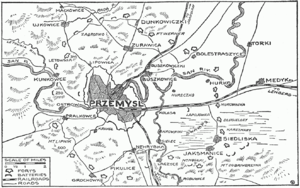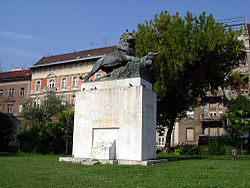Siege of Przemysl - Picture
More about World War 1

|
|
Siege of Przemysl
Date: Date
24 September 1914 - 22 March 1915
Location
Przemysl, present day Poland
Result
Russian victory
Date: 24 September 1914 - 22 March 1915
Location: Przemysl, present day Poland
Result: Russian victory
Belligerents:
: Russian Empire
Commanders and leaders:
: Radko Dimitriev
Andrei N. Selivanov
Strength:
: 300,000
Casualties and losses:
: 115,000 total casualties (40,000 casualties were sustained in the first few days of the siege)
Vistula River - Limanowa - Bolimx³w - 2nd Masurian Lakes - Gorlice-Tarnx³w - Great Retreat - Sventiany Offensive - Lake Naroch - Brusilov Offensive - Kowel - Kerensky Offensive - Operation Albion
The Siege of Przemysl was one of the greatest sieges of the First World War, and a crushing defeat for Austria-Hungary. The investment of Przemysl began on September 24, 1914 and was briefly suspended on October 11 due to an Austro-Hungarian offensive. The siege resumed again on November 9 and the Austro-Hungarian garrison surrendered on March 22, 1915 after holding out for a total of 133 days.
Background

Picture - Przemysl and surrounding forts
During the Russian offensive from Galicia into Lemberg in 1914, General Nikolai Ivanov overwhelmed the Austro-Hungarian forces under Conrad von Hx¶tzendorf during the Battle of Galicia, and the whole Austrian front fell back over 100 miles (160 km) to the Carpathian Mountains. The fortress at Przemysl was the only Austrian post that held out and by September 28 was completely behind Russian lines. The Russians were now in a position to threaten the German industrial region of Silesia, making the defense of Przemysl of importance to the Austro-Hungarians as well as the Germans.
First siege
On September 24, General Radko Dimitriev, commander of the Russian Third Army began the siege of the fortress. Dimitriev was without sufficient siege artillery when he began the investment and instead of waiting for the Russian high command to send him the artillery pieces, Dimitriev ordered a full scale assault on the fortress before an Austrian relief force could be sent. For three days the Russians attacked and accomplished nothing at the cost of 40,000 casualties. While this was under way General Paul von Hindenburg launched an offensive against Warsaw in the north. In conjunction with the German attack on Warsaw, General Svetozar Boroevic von Bojna led a relief force towards Przemysl. On October 11 Dimitriev lifted the siege and withdrew across the San River. Conrad von Hx¶tzendorf had hopes that a combined assault from Boroevic's army and the Przemysl garrison would inflict a severe blow on the Russians.
Second siege
By October 31, Hindenburg had been defeated at the Battle of the Vistula River and withdrew from his assault on Warsaw. This caused Boroevic to pull back from the San River line, and abandon von Hx¶tzendorf's proposed offensive against Russia. On November 9 the Russians resumed the siege of Przemysl. Radko Dimitriev's force was withdrawn from the Przemysl sector and moved north. The Russian Eleventh Army under General Andrei Nikolaevich Selivanov took up the siege operations. Selivanov did not order any frontal assaults as Dimitriev had, and instead settled to starve the garrison into submission. In February, 1915 Boroevic led another relief effort towards Przemysl.
By the end of February all relief efforts had been defeated and von Hx¶tzendorf informed Hermann Kusmanek von Burgneustx¤dten that no further efforts would be made. Selivanov was given sufficient artillery to reduce the fortress. The Russians overran the northern defenses on March 13. An improvised line of defense held up the Russian attacks long enough for Kusmanek to destroy anything left in the city that could be of use to the Russians once captured. On March 19 Kusmanek ordered an attempt to break out but his sallies were repulsed and he was forced to retreat back into the city. With nothing useful left within the city, Kusmanek had no choice but to surrender. On March 22 the remaining garrison of 117,000 surrendered to the Russians. Among the captured were nine generals, ninety-three senior staff officers, and 2500 other officers.
Mail communications
The world's first airmail flights from Przemysl during both sieges when airmail postcards, mostly military mail, were flown from the besieged city on twenty seven flights. Following a forced landing, mail from one flight was confiscated by the Russians and sent to Petrograd for postal censorship and onward transmission. Balloon mail, on manned but mainly unmanned paper balloons, was also carried out of the city. Pigeon mail was also used to send messages out of the city.
Results

Picture - Statue commemorating the siege of Przemysl in Budapest, Hungary
The fall of Przemysl led many to believe that Russia would now launch a major offensive into Hungary. This anticipated offensive never came, but the loss of Przemysl was a serious blow to Austro-Hungarian morale. A further blow to Austria-Hungary was the fact that Przemysl was only supposed to be garrisoned by 50,000, yet over 110,000 Austrians surrendered with the fortress, a much more significant loss. The Russians held Przemysl until the summer of 1915 when an Austro-Hungarian and German offensive pushed back the Russian front in Galicia.
References and sources
Sources
Tucker, Spencer The Great War: 1914-18 (1998)
More aircraft.
Source: WikiPedia